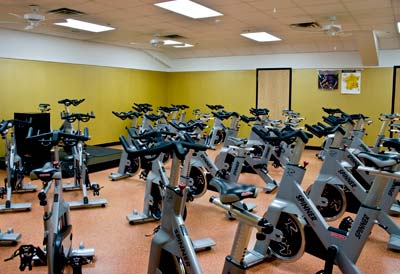
Music is such an important part of our classes and yet I can find very little information available about what can be done to improve the quality of the sound in the studios where we teach.
That scarcity of info ends starting today with this article, which is cross posted over at www.cyclingstudio.org
Intro from Barbara Hoots —spinroomdesign.com
As an indoor cycling studio designer, I”™m often asked how to prevent class music from pumping through the walls and disturbing businesses next door. After interviewing many reputable sound control companies, Ryan Gibbons with Auralex wowed me with his brilliance and agreed to submit an article that would outline acoustical treatment options that studio owners can implement to ensure a happy environment for all. If you”™re considering opening a studio, read this first!
Total Sound Control
By Ryan Gibbons, Sound Applications Specialist
As we all know, indoor cycling classrooms can present an array of acoustical issues for both studio owners and customers alike. Loud music levels and equipment noise can translate to a harsh acoustical environment inside the studio and can disturb neighboring businesses which ultimately leads to lower profits. Obviously, having happy customers and neighbors is essential to a successful business.
A question we often hear at Auralex is, “If I put some of your foam on the walls, will it keep my neighbors from hearing my music?” The answer is unfortunately a qualified “No.” We refer to the limiting of transmission of sound between structures as “isolation.” Properly isolating a space requires construction materials and would likely require a remodel of an existing space. This can be a time-consuming and sometimes expensive process; however, if done correctly it can be well worth the effort.
From our experience, the most efficient way to eliminate room-to-room sound transmission is to build what we call a “room within a room.” This involves two steps. First, decoupling (acoustically separating) the new structure from the existing structure is important to eliminate structure-borne vibrations. Generally these vibrations are caused by low-frequencies travelling through the walls, ceiling, and floor. This can translate to your attached neighbors as “boomy.” Decoupling the structure can help control those vibrations, thus reducing the amount of noise people in the other structures hear. Next, we suggest placing mass (drywall/sheetrock and insulation) between the existing structures to help control higher frequencies from travelling through the existing walls. Accomplishing these two steps should help improve your relationship with your neighbors considerably.
Auralex has a publication on the web called “Acoustics 101.” This is a great resource that can help guide you or your general contractor through the proper construction to isolate your space. It provides detailed drawings on the topics discussed, and is easy to read and understand. You can find this publication on the web at www.acoustics101.com. Also see our page, Bothering Your Neighbors? for helpful diagrams and audio clips.
When it comes to interior acoustics, there are many solutions for these dilemmas and a wide array of products designed to help you reach a comfortable acoustic environment. The two most commonly-used sound absorption materials are high-quality acoustic foam and specialized acoustic fiberglass (no, not the stuff you buy at the hardware store). For brevity, at times we”™ll generically call acoustic foam just plain “foam,” although there are very dramatic differences in cell structure and density between acoustic foam and the thousands of other types we could manufacture. (This is why you can”™t just run down to the local SuperMart and buy mattress pads with which to acoustically treat your studio.)
In addition to the two most popular types of acoustic absorption materials, a Class A, fire resistant, natural fiber panel called SonoFiber. SonoFiber acoustic panels are the perfect solution for those budget-conscious projects requiring a Class A fire rating without the aesthetic demands of designer treatments such as fabric-covered panels.
Acoustic sound absorption foam is well-suited to alleviate slap and flutter echo, the two most common problems in rooms not specifically designed for music recording and performance. In fact, foam can turn even the most cavernous warehouse or gymnasium into a suitable acoustic environment.
Feel free to contact me if you have any specific questions about your studio, and I”™ll be happy to provide any assistance, suggestions, or solutions. You can contact me at Aurale via email at auralexinfo@auralex.com or by calling 1.800.959.3343.
I have an interview scheduled with Ryan on Thursday March 24th. If you have a question you would like me to ask him send it to john@indoorcycleinstructor.com by the end of Wednesday the 23rd.

John,
That was very informative – I often wondered about this particular process that privately owned studios/businesses need to consider.
It’s really great that ICI/Pro provides such great 411 to its
members…I really look forward to visiting this website regularly.
Thank you,
Mr.Wilson
Cute story: On the flight to Vermont to teach Ride for a Reason, I sat next to a young man going to school in L.A. for a degree in recording studio production. I mentioned the article by Ryan Gibbons and his eyes got wide. He stammered a bit and finally said, “Dude, you guys at ICI must be serious. Auralex is the best in the business – you have to be insanely good to work there.”
Very useful article John I’m looking for a solution in isolate betwen floors when you have already a suspended celing , looking toknow more of this interview, great info ICI!